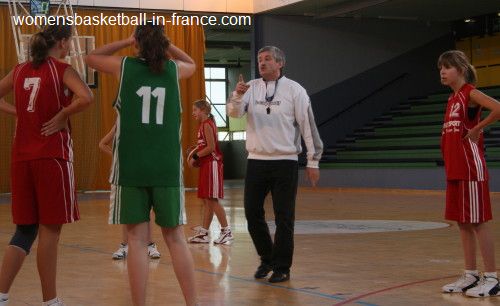|
Youth basketball structure in France In France the youth basketball structure is well developed with more than 20,000 female players registered by the Fédération Française de Basket-ball (FFBB). There are also a number of other smaller associations in France that organise basketball competitions during the weekend that are not affiliated to the FFBB. In France age groups for basketball is based on the year of birth (1 January - 31 December) and the classifications are as follows: Junior(18-20) Basketball is also played in schools but on a much smaller scale to club basketball. From the age of 11 students have the opportunity to attend schools that offer basketball as a main activity, the "sport etude". In these schools the students have an option to add 3-4 hours additional sport practice, such as basketball, football and so on. Students from these schools tend to participate in competitions organised by the "Union Nationale du Sport Scolaire (UNSS)". Within the UNSS structure there are various classifications so that schools can contest national titles with teams at the same level. This competition is not exclusively for schools that have "Sport étude" as an option.
|
| |
Between the age of 13 and 15 promising young players can attend what is called the "Pôle Espoirs".
This option is available for about 200 players a year.
The players are given 10 hours a week basketball training and must play in the French National Championship (Minimes or Cadets).
The players’ school timetable is arranged so that they can either have early morning training during the first periods of the day or evening sessions so as not to miss any school.
Some of the schools these player attend, usually enter their school in the UNSS competitions.
Most of the players that attend the pôle espoirs programme represent the region of the in the regional competitions for U15's.
After leaving this structure they normally enter a basketball academy (Centre de Formation LFB). However between 8-10 players are admitted into the CFBB.
Between the age of 15 until 18 youth basketball players continue their basketball education at clubs all over the country.
We use the term basketball academy for any club that has a structure for basketball development because in France only clubs in the LFB are allowed to use the label "centre de formation".
There are clubs in the lower divisions that have structures in place that are at the same level as those in the LFB that are recognised by the FFBB but most of the clubs use another label.
From 2009-2010 the page is updated with information about the various basketball structures with interviews from people running these institutions.
The links for the reports conducted during the 2007-2008 season are not updated but have been included on this page for reference purposes.
You can move to any section by clicking on the link below or by scrolling down the page.
1.Club development information for youth players
2.Basketball Academy News information from 2007-2008
Club development news and programmes
16 May 2010: Bourges defeat Mondeville in the U18 Coupe de France final
10 February 2009: Try-out dates for basketball youth academies in France
23 October 2009: Illkirch-Graffenstaden basketball academy is important for the club
Return to index
Basketball academy articles from 2007-2008 season
Fréderic Dusart explains the structure at Villeneuve d'Ascq
Return to index
Return from youth basketball information page to "What's New" page
Youth basketball picture credits:
womensbasketball-in-france.com
Date created: 20 October 2009
Last Update: 16 May 2010





